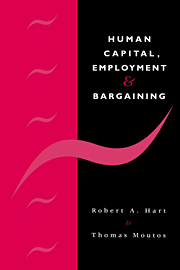Book contents
- Frontmatter
- Contents
- Preface
- 1 Overview
- 2 Labour demand and efficient contract models
- 3 Turnover costs, firm-specific training and unemployment
- 4 Employment and bargaining
- 5 Choice of compensation, unemployment insurance and policy issues
- 6 Team-related human capital and bargaining
- 7 Coalitional versus neoclassical firms
- 8 Future developments
- Bibliography
- Index
4 - Employment and bargaining
Published online by Cambridge University Press: 05 November 2011
- Frontmatter
- Contents
- Preface
- 1 Overview
- 2 Labour demand and efficient contract models
- 3 Turnover costs, firm-specific training and unemployment
- 4 Employment and bargaining
- 5 Choice of compensation, unemployment insurance and policy issues
- 6 Team-related human capital and bargaining
- 7 Coalitional versus neoclassical firms
- 8 Future developments
- Bibliography
- Index
Summary
Why bargaining?
The remainder of this book is dominated by the analysis of bargaining models of the labour market. More specifically, it is concerned largely with bargaining negotiations between two parties, one representing the interests of the firm and the other those of employees. In this section, we discuss two interrelated questions. First, why might the bargaining parties find it to be in their mutual interest that workers are collectively represented by a trade union? Secondly, why might trade union representation be particularly encouraged when the organisation of production involves a high degree of human capital asset specificity? The remaining sections of the chapter concentrate on developing and discussing the bargaining framework that dominates later developments. For ease and efficiency of exposition, we do not model the role of human capital in these sections. We continue to concentrate on employment and bargaining issues in chapter 5, revisiting several of the labour demand topics discussed earlier. Chapters 6 and 7 are devoted to bargaining models that explicitly incorporate the costs and returns of human capital investments.
That it may be in the interest of individual workers to form a monopoly in order to offset the monopsonistic power of an employer is not a matter of dispute. To give an extreme example, assume that the demand for a firm's product is inelastic up to price p and zero for prices above it.
- Type
- Chapter
- Information
- Human Capital, Employment and Bargaining , pp. 77 - 95Publisher: Cambridge University PressPrint publication year: 1995



